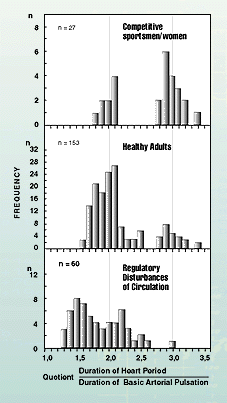A further example for the economical importance of harmonic frequency and phase co-ordination is the ratio of heart rhythm and inherent oscillation of the arterial system. The ejection of blood out of the heart triggers rhythmic oscillation of the elastic arterial system which is normally double as fast as the heart rhythm. With a whole numbered co-ordination, the ejection of blood from the heart always hits the same phase of the arterial pressure variations, whereby up to 30% heart energy can be saved.
Illustration 16 shows frequency distributions of the quotient from heart periodic duration and arterial basic oscillation duration. The normal whole numbered ratio of 2:1 is preferred by healthy people, more strictly even by trained sports people whose circulation is more economically adjusted. With a slower heart rate the ratio of 3:1 can also be adjusted. In patients with functional cardiac-vascular disorders with negative organic results, however, the whole numbered-harmonic co-ordination was completely missing (illustration 16, below).

